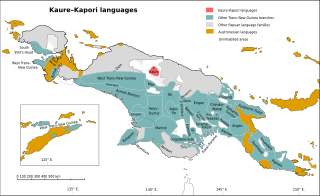Related Research Articles

The Papuan languages are the non-Austronesian and non-Australian languages spoken on the western Pacific island of New Guinea, and neighbouring islands, by around 4 million people. It is a strictly geographical grouping, and does not imply a genetic relationship. The concept of Papuan peoples as distinct from Austronesian-speaking Melanesians was first suggested and named by Sidney Herbert Ray in 1892.
Stephen Adolphe Wurm was a Hungarian-born Australian linguist.
The Border or Upper Tami languages are an independent family of Papuan languages in Malcolm Ross's version of the Trans–New Guinea proposal.
The Piawi languages are a small family of Papuan languages spoken in the Schraeder Range of the Madang Highlands of Papua New Guinea that had been part of Stephen Wurm's Trans–New Guinea proposal. They are now connected to the Arafundi and Madang languages.
The Burmeso language – also known as Taurap – is spoken by some 300 people in Burmeso village along the mid Mamberamo River in Mamberamo Tengah subdistrict, Mamberamo Raya Regency, Papua province, Indonesia. It is surrounded by the Kwerba languages to the north, the Lakes Plain languages to the south, and the East Cenderawasih Bay languages to the west.

The Central Solomon languages are the four Papuan languages spoken in the state of the Solomon Islands.

The Greater Awyu or Digul River languages, known in earlier classifications with more limited scope as Awyu–Dumut (Awyu–Ndumut), are a family of perhaps a dozen Trans–New Guinea languages spoken in eastern West Papua in the region of the Digul River. Six of the languages are sufficiently attested for a basic description; it is not clear how many of the additional names may be separate languages.
The Pauwasi languages are a likely family of Papuan languages, mostly in Indonesia. The subfamilies are at best only distantly related. The best described Pauwasi language is Karkar, across the border in Papua New Guinea. They are spoken around the headwaters of the Pauwasi River in the Indonesian-PNG border region.

The Kaure–Kosare or Nawa River languages are a small family spoken along the Nawa River in West Papua, near the northern border with Papua New Guinea. The languages are Kaure and Kosare.

The Eleman languages are a family spoken around Kerema Bay, Papua New Guinea.

The Duna–Pogaya (Duna–Bogaia) languages are a proposed small family of Trans–New Guinea languages in the classification of Voorhoeve (1975), Ross (2005) and Usher (2018), consisting of two languages, Duna and Bogaya, which in turn form a branch of the larger Trans–New Guinea family. Glottolog, which is based largely on Usher, however finds the connections between the two languages to be tenuous, and the connection to TNG unconvincing.

The Gogodala–Suki or Suki – Aramia River languages are a small language family of Papua New Guinea, spoken in the region of the Aramia River. The four language are clearly related.

The East Strickland or Strickland River languages are a family of Papuan languages.
The Mailuan or Cloudy Bay languages are a small family of Trans–New Guinea languages spoken around Cloudy Bay in the "Bird's Tail" of New Guinea. They are classified within the Southeast Papuan branch of Trans–New Guinea.
The Kwalean or Humene–Uare languages are a small family of Trans–New Guinea languages spoken in the "Bird's Tail" of New Guinea. They are classified within the Southeast Papuan branch of Trans–New Guinea.

Pawaia, also known as Sira, Tudahwe, Yasa, is a Papuan language that forms a tentative independent branch of the Trans–New Guinea family in the classification of Malcolm Ross (2005).
Foi, also known as Foe or Mubi River, is one of the two East Kutubuan languages of the Trans-New Guinea family spoken along Lake Kutubu and Mubi River, located in the Southern Highlands Province of Papua New Guinea. Dialects of Foi are Ifigi, Kafa, Kutubu, Mubi. A Swadesh list for the Foi language was documented by The Rosetta Project in 2010. The estimated number of Foi speakers as of 2015 is between 6,000 and 8,000.
Darrell T. Tryon was a New Zealand-born linguist, academic, and specialist in Austronesian languages. Specifically, Tryon specialised in the study of the languages of the Pacific Islands, particularly Vanuatu, the Solomon Islands, and the French-speaking Pacific.
Ngatikese, or Sapwuahfik, is a Micronesian language originating on Sapwuahfik atoll, Federated States of Micronesia. Of the 700 Ngatikese speakers, only about 450 live on Sapwuahfik. It was previously considered a distinct dialect of Pohnpeian, but was later reclassified as the two proved to be only partially mutually intelligible. It is currently considered vulnerable, as many of its speakers have gradually shifted to Pohnpeian.
Tom Dutton is an Australian linguist specialising in Papuan languages and other languages of Papua New Guinea.
References
- ↑ Pawley, A. "Tom Dutton: linguist". In Pawley, A., Ross, M. and Tryon, D. editors, The boy from Bundaberg: Studies in Melanesian linguistics in honour of Tom Dutton. PL-514:1-12. Pacific Linguistics, The Australian National University, 2001. doi : 10.15144/PL-514.1
- ↑ Editorial board, Pacific Linguistics.